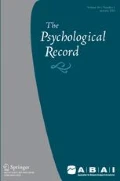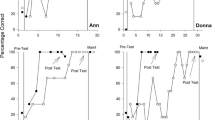Abstract
Equivalence classes were formed of the names (A), time periods (B), and characteristics (C) of three stages of prenatal development of the students in a classroom. The baseline relations for these classes (AB and CB) were established on a group basis by the students in a classroom through the use of “feedback-enhanced clicker-training”. Thereafter, class formation was tracked on an individual basis with a very quickly administered sorting test. Classes emerged immediately for 84 % of 32 students in a single 75-minute class session. Thus, many students showed the immediate formation of equivalence classes when training was done on a group basis with a feedback-enhanced form of clicker training, and a sorting test was used to track class formation. We also considered some likely mechanisms that could account for learning the baseline relations by individual participants during clicker training. Finally, we considered the feasibility of using a clickers and sorting protocol to implement equivalence-based instruction.





Similar content being viewed by others
References
Albright, L., Reeve, K. F., Reeve, S. A., & Kisamore, K. A. (2016). Teaching statistical variability with equivalence-based instruction. Journal of Applied Behavior Analysis, 48, 883–894. doi:10.1002/jaba.249.
Arntzen, E. (2004). Probability of equivalence formation: Familiar stimuli and training sequence. The Psychological Record, 54, 275–291.
Arntzen, E., Norbom, A., & Fields, L. (2015). Sorting: An alternative measure of class formation? The Psychological Record, 65, 615–625. doi:10.1007/s40732-015-0132-5.
Bruff, D. (2009). Teaching with classroom response systems: Creating active learning environments. Josey-Boss: Vanderbilt University.
Cowley, B. J., Green, G., & Braunling-McMorrow, D. (1992). Using stimulus equivalence procedures to teach name-face matching to adults with brain injuries. Journal of Applied Behavior Analysis, 25, 461–475.
Critchfield, T. S., & Fienup, D. M. (2010). Using stimulus equivalence technology to teach about statistical inference in a group setting. Journal of Applied Behavior Analysis, 43, 763–768.
Dickins, D. W. (2011). Transitive inference in stimulus equivalence and serial learning. European Journal of Behavior Analysis, 12, 523–555.
Dickins, D. W. (2015). A Simpler Route to Stimulus Equivalence? A Replication and Further Exploration of a “Simple Discrimination Training Procedure” (Canovas, Debert and Pilgrim 2014). The Psychological Record, 1–11. doi:10.1007/s40732-015-0134-3.
Dymond, S., & Rehfeldt, R. A. (2001). Supplemental measures and derived stimulus relations. Experimental Analysis of Human Behavior Bulletin, 19, 8–12.
Eilifsen, C., & Arntzen, E. (2009). On the role of trial types in tests for stimulus equivalence. European Journal of Behavior Analysis, 10, 187–202.
Eilifsen, C., & Arntzen, E. (2011). Single-subject withdrawal designs in delayed matching-to-sample procedures. European Journal of Behavior Analysis, 12, 152–172.
Fields, L., Arntzen, E., Nartey, R. K., & Eilifsen, C. (2012). Effects of a meaningful, a discriminative, and a meaningless stimulus on equivalence class formation. Journal of the Experimental Analysis of Behavior, 97, 163–181. doi:10.1901/jeab.2012.97-163.
Fields, L., Arntzen, E., & Moksness, M. (2014). Stimulus sorting: A quick and sensitive index of equivalence class formation. The Psychological Record, 64, 487–498.
Fields, L., Hobbie, S. A., Reeve, K. F., & Adams, B. J. (1999). Effects of training directionality and class size on equivalence class formation by adults. The Psychological Record, 49, 703–724.
Fields, L., Travis, R., Yadlovker, D. E., Roy, D., de Aguiar-Rocha, L., & Sturmey, P. (2009). Equivalence class formation: A method for teaching statistical interactions. Journal of Applied Behavior Analysis, 42, 575–593.
Fields, L., & Verhave, T. (1987). The structure of equivalence classes. Journal of the Experimental Analysis of Behavior, 48, 317–332.
Fienup, D. M., Covey, D. P., & Critchfield, T. S. (2010). Teaching brain-behavior relationships economically with stimulus equivalence technology. Journal of Applied Behavior Analysis, 43, 19–33.
Fienup, D. M., & Critchfield, T. S. (2010). Efficiently establishing concepts of inferential statistics and hypothesis decision making through contextually-controlled equivalence classes. Journal of Applied Behavior Analysis, 43, 437–462.
Fienup, D. M., & Dixon, M. R. (2006). Acquisition and maintenance of visual-visual and visual-olfactory equivalence classes. European Journal of Behavior Analysis, 6, 87–98.
Fienup, D. M., Mylan, S. E., Brodsky, J., & Pytte, C. (2016). From the laboratory to the classroom: The effects of equivalence-based instruction on neuroanatomy competencies. Journal of Behavioral Education, 25, 143–165. doi:10.1007/s10864-015-9241-0.
Fienup, D. M., Wright, N. A., & Fields, L. (2015). Optimizing equivalence based instruction: Effects of training protocols on equivalence class formation. Journal of Applied Behavior Analysis, 48, 1–19.
Goldstein, D. S., & Wallis, P. D. (2015). Clickers in the classroom: Using classroom response systems to increase student learning. Sterling, VA: Stylus.
Green, G. (1990). Differences in development of visual and auditory-visual equivalence relations. American Journal of Mental Deficiency, 95, 260–270.
Hove, O. (2003). Differential probability of equivalence class formation following a one-to-many versus a many-to-one training structure. The Psychological Record, 53(4), 617–634.
Keller, F. S. (1943). Studies in International Morse Code. A new method of teaching code reception. Journal of Applied Psychology, 27, 407–415.
Lovett, S., Rehfeldt, R. A., Garcia, Y., & Dunning, J. (2011). Comparison of a stimulus equivalence protocol and traditional lecture for teaching single-subject designs. Journal of Applied Behavior Analysis, 44, 819–833.
Lowe, C. F., Horne, P. J., Harris, F.D., & Randle, V. R. L. (2002). Naming and categorization in young children: Vocal tact training. Journal of the Experimental Analysis of Behavior, 78, 527–549. doi: 10.1901/jeab.2002.78-527
Mackay, H. A., Wilkinson, K. M., Farrell, C., & Serna, R. W. (2011). Evaluating merger and intersection of equivalence classes with one member in common. Journal of the Experimental Analysis of Behavior, 96, 87–105. doi:10.1901/jeab.2011.96-87.
Mazur, E. (2013). Peer Instruction: Pearson New International Edition: A User's Manual (1st Ed). Pearson.
Patry, M. W. (2009). Clickers in large classes: From student perceptions towards an understanding of best practices. International Journal of the Scholarship of Teaching and Learning, 3, 1–11 (available at http://www.georgiasouthern.edu/ijsotl ).
Pilgrim, C., & Galizio, M. (1996). Stimulus equivalence: A class of correlations or a relation of classes. In T. R. Zentall & P. M. Smeets (Eds.), Stimulus class formation in humans and animals (pp. 173–195). Amsterdam: Elsevier.
Saunders, R. R., Wachter, J. A., & Spradlin, J. E. (1988). Establishing auditory stimulus control over an eight–member equivalence class via conditional discrimination procedure. Journal of the Experimental Analysis of Behavior, 49, 95–115.
Sidman, M. (1971). Reading and auditory-visual equivalences. Journal of Speech and Hearing Research, 14, 5–13.
Sidman, M. (1994). Equivalence relations and behavior: A research story. Boston, MA: Authors Cooperative.
Sidman, M., & Cresson, O., Jr. (1973). Reading and crossmodal transfer of stimulus equivalences in severe retardation. American Journal of Mental Deficiency, 77, 515–523.
Sigurdardottir, Z. G., Mackay, H. A., & Green, G. (2012). Stimulus equivalence, generalization, and contextual stimulus control in verbal classes. The Analysis of Verbal Behavior, 28, 3–29.
Smeets, P. M., Dymond, S., & Barnes-Holmes, D. (2000). Instructions, stimulus equivalence, and stimulus sorting: Effects of sequential testing arrangements and a default option. The Psychological Record, 50(2), 339–354.
Spradlin, J. E., & Saunders, R. R. (1986). The development of stimulus classes using match–to–sample procedures: Sample classification versus comparison classification. Analysis and Intervention in Developmental Disabilities, 6, 41–58.
Stowell, J. R., & Nelson, J. M. (2007). Benefits of electronic audience response systems on student participation, learning, and emotion. Teaching of Psychology, 34, 253–258.
Walker, B. D., & Rehfeldt, R. A. (2012). An evaluation of the stimulus equivalence paradigm to teach single-subject design to distance education students via blackboard. Journal of Applied Behavior Analysis, 45, 329–344.
Walker, B. D., Rehfeldt, R. A., & Ninness, C. (2010). An evaluation of the stimulus equivalence paradigm to teach single-subject design to distance education students via blackboard. Journal of Applied Behavior Analysis, 43, 615–633.
Zinn, T. E., Newland, M. C., & Ritchie, K. E. (2015). The efficiency and efficacy of equivalence based learning: A randomized control trial. Journal of Applied Behavior Analysis, 48, 865–882.
Author information
Authors and Affiliations
Corresponding author
Ethics declarations
All procedures performed in this study, which involved human participants, were in accordance with the ethical standards of the institutional and/or national research committee and with the 1964 Helsinki declaration and its later amendments or comparable ethical standards.
Conflict of Interest
Both of the authors declare that they have no conflict of interest.
Informed consent
Informed consent was obtained from all individual participants included in the study.
Rights and permissions
About this article
Cite this article
Varelas, A., Fields, L. Equivalence Based Instruction by Group Based Clicker Training and Sorting Tests. Psychol Rec 67, 71–80 (2017). https://doi.org/10.1007/s40732-016-0208-x
Published:
Issue Date:
DOI: https://doi.org/10.1007/s40732-016-0208-x




